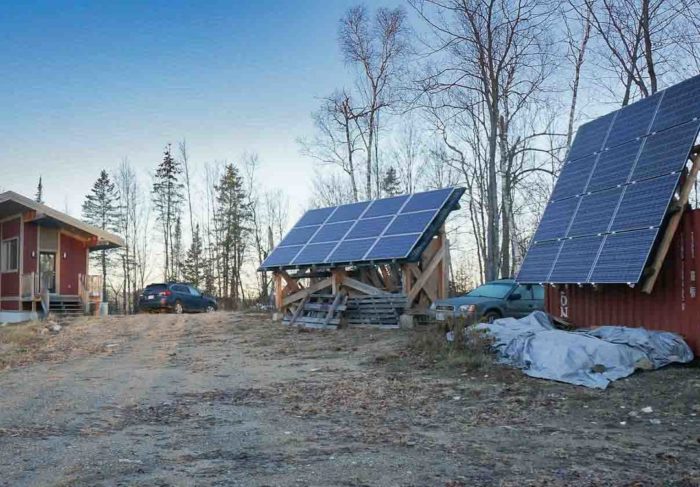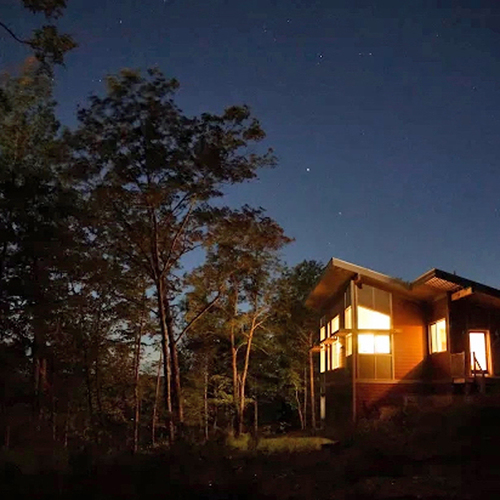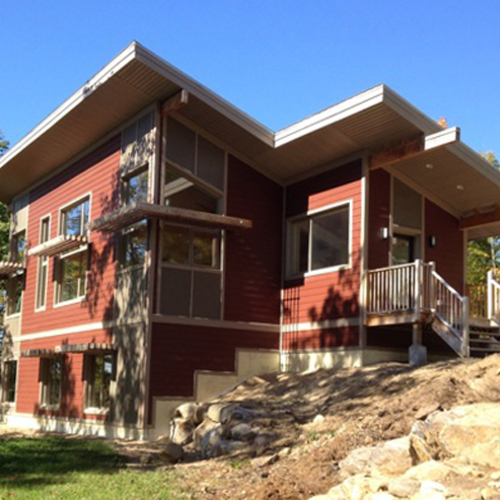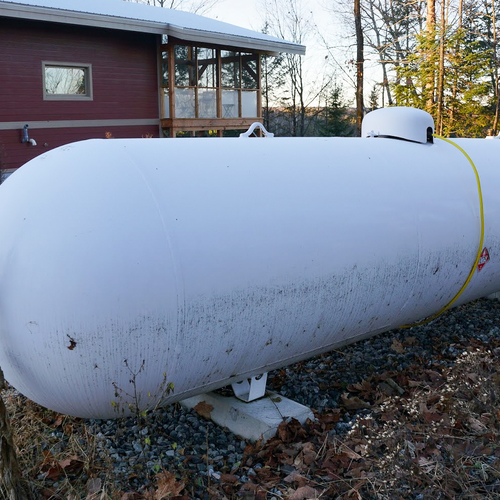Image Credit: Craig Anderson
Image Credit: Craig Anderson Counting the electrons: Here's is Craig Anderson's updated energy budget showing how much electricity each device in the house consumes.
This is one of a series of posts by Craig Anderson describing the off-the-grid house he built with his wife France-Pascale Ménard near Low, Québec. Craig writes about the “Seven Hills Project” in a blog called Sunshine Saved. For a list of Craig’s previous posts, see the list of “Blogs by Craig Anderson” in the sidebar below. This post originally appeared in November 2015.
For better or worse, the property my wife and I fell in love with was over a mile down a private road where our few neighbors have summer-only cabins. There are no services of any kind: no phone, no cable, no fiber-optics, and, of course, no power lines.
Our neighbors heat with wood when needed, and handle cooking and a small amount of power generation with propane generators. I looked briefly into bringing power lines to our site, but an off-grid solution became the obvious choice when I realized the price would greatly exceed $100,000 just to put in power poles. I already had quite an interest in sustainable energy and solar power, so this provided just the impetus I needed to pursue an off-grid home.
I’ll list the vital statistics of our system first, and then say a bit about how the system has worked so far, as well as detail the updates we’ve made.
Our electricity generating system consists of these components:
- Photovoltaic panels: 12 Solarworld 235-watt panels (2820 W total).
- Additional panels (installed in fall 2015): 12 Jinko 250-watt panels (3000 W total).
- Batteries: Eight Deka deep-cycle solar batteries, lead acid, AGM 12V, 265 Ah (a nominal 25 kWh storage).
- Backup generator: 6 kW Generac Ecogen.
- Electronics: Schneider MPPT 80-600 charge controller, Schneider Conext SW 4048 inverter/charger, Schneider Combox, Schneider automatic generator starter.
How the pieces fit together
Any electrical grid starts with power generation, and ours is no different. The majority of the time, all of our electricity needs are supplied by solar panels. However, there are times when the panels can’t produce enough power (at night and on cloudy days). Generally, the batteries store enough energy to get us through a couple of days without much sun. When the battery charge gets too low, the backup propane generator starts. It sends power into the house, via an alternator, to be used both to power the house and charge the batteries.
The electronics provide for energy transformations and communications. The charge controller takes high voltage power coming from the solar panels, and steps it down so just the right amount and voltage (a bit over 48 volts DC) is passed on to the other systems.
Most of this power is dumped straight into the batteries, which chemically store that electricity for later use. When power is needed for loads in the house, that 48-volt power coming from the batteries and charge controller is drawn into the inverter, which converts the power into the normal household power found in any home, 120-volt alternating current, which goes out through a standard breaker panel to the house.
The inverter is actually an inverter/charger, so in addition to taking DC power from the batteries and solar panels out to the house, it also can convert AC power from the generator into DC power to charge the batteries. The automatic generator starter is able to start the generator whenever the battery voltage falls below a certain level, ensuring that the batteries are never discharged too deeply.
Finally, the Combox provides an interface for controlling all of the other devices, as well as being able to connect to the internet, allowing me to to check the system remotely and send regular system status updates by email to myself.
Solar panel orientation
There is a simple rule of thumb I learned from our solar installer when we were discussing our system setup: the best orientation for stationary panels is due south, with an angle equal to the latitude. This maximizes the annual output of power from a given solar panel. We are at 45° north, so we ought to set our panels at the same angle to the ground. For our original panels, we were able to get this orientation, due south and at a 45° angle.
During our first winter, I realized there are some nuances for an off-grid system in the north country that aren’t captured by that rule of thumb. There are two main problems. The first is snow. It turns out that panels set at 45° don’t shed snow as well as I’d hoped. The snow will clear after a day or so of sunny weather, but while the snow is still there, the panels produce no power. Clearing them manually works fine, but we are not always there to do it.
The second problem is that an off-grid home is not in the business of producing the maximum total power over the year, it is about always having enough power available to keep the house running. Our summer power loads are extremely low, as no heating is needed, days are long and so little lighting is needed, and we are outside much more often. In the winter, when there is already less sun, our electricity needs are actually much higher.
These two problems have a shared solution: Set the solar panels at a much steeper angle. This allows them to shed snow very easily, and squares the panels much better to the low-angled winter sun. Of course, it is possible to get around this problem with such things as seasonably adjustable solar panels, or the significantly more complicated sun-tracking systems, but the simplicity (and reduced cost) of fixed panels is quite attractive. I would go so far as to say that if one is going to have stationary panels in the northern U.S. or Canada on an off-grid home, orienting them for winter is the best path to follow.
In our first two winters, we were overly reliant on our (poorly functioning) generator through the winter, and so earlier this fall, we added an additional solar array set at an angle of 65° from the ground. These should greatly reduce the amount of run-time that will be needed from the generator in future winters. As you can see from the photos, the new panels also are turned a bit to the south-west, which is intentional. There is a better clearing in the trees toward the west, and so the new panels are turned a bit so that they will be receiving direct sun for a greater portion of the day.
Power generation through the year
I’ve attached the power production estimate that my solar installer created for me prior to installing the system. (Use this link to read the files.). While a few details changed after these estimates were made, there is an incredible wealth of data here about our local solar resource, expected consumption of power at our home, the efficiencies of the various components of an off-grid power system, and more. For readers who may actually be considering building an off-grid system, these are the sort of nitty-gritty details you will need to consider.
Electricity use and patterns
It is a bit tricky to build an energy budget for an off-grid home. It requires much more planning than with a typical home, as one has to figure out all the details in advance. At the beginning of the planning process, I made a list of all of the electricity that we could expect to use, and then followed that up by trying to make sure all purchase decisions would fit into that energy budget.
As I mentioned in my previous post, the one significant mistake we made was to have a heating system that required electricity to run. The power requirements wouldn’t be much for a typical house, but is tough for an off-grid house in the winter.
It is currently much more expensive to generate energy off the grid than to buy grid power, so one has to be very careful to make everything as efficient as possible. If we were connected to the local utility, Hydro-Quebec, our electricity rates would be less than 10 cents per kWh, some of the cheapest power available anywhere in the world. However, with our backwoods location, generating our own power was the only viable option.
When I estimate the cost and expected lifetime of all of our solar panels, electronics, batteries, backup generator, etc., our power cost will end up being much closer to $1/kWh, at least 10 times the cost of grid power. This means that economizing and conserving is the only way to keep the total cost of power reasonable.

Below, I have attached a fairly accurate version of our energy budget updated to account for our first full year of use. At all times we run a refrigerator, an HRV, the solar electronics, and a few other electronics that make up our internet and security systems. In the winter, the boiler also runs nearly every day to keep the house heated. On top of that, we have pretty bare bones usage of power compared to a typical home, and I’ve done my best to reduce the vampire loads down to almost nothing.
Our total electricity usage for the past year was a bit less 1,500 kWh, which makes an average of roughly 4 kWh/day. Our 1,500 kWh of electricity use is dwarfed by the typical household in Canada, which uses an average of 11,900 kWh (32.6 kWh/day). While our place is extremely efficient, I must make clear that one of the reasons our usage is so low is that we are only in the house a bit less than half of the time, as work and other responsibilities call us into the city far more often than I would like. If one factors in the power that we use in our rental in the city, we still are below average, but not by all that much. We are striving to reduce our energy consumption, especially of non-renewable energy, but it is a task that takes time to accomplish.
One other disclaimer to make is that our electricity use still makes up significantly less than half of our total energy use. The technology is simply not yet available (at any sort of reasonable price) to heat a house through a cold, gray, and snowy Canadian winter with solar power alone. Propane and/or wood are an absolute necessity to be able to stay warm out in the countryside.
With the fast-dropping prices of solar modules, batteries, as well as improved building envelopes and heating technologies like air-to-air heat pumps, this may become a possibility a decade or two down the road, but the time is not yet ripe.
Weekly Newsletter
Get building science and energy efficiency advice, plus special offers, in your inbox.
















5 Comments
Generator problems?
You mentioned generator problems. I suspect that the problem is that propane generators have difficulty starting at very low temperatures as is the case in your area. Diesel is better for that, although not foolproof. Some kind of pre heat for the generator is the best solution. Even a small propane heater in the generator shed that is set at minimum temp will do the trick. However you need an insulated generator shed with a powerful cooling exhaust fan for when the generator heats the shed too high. This is what I have used for years, however we live off grid full time.
Even a heater just on pilot might do the trick.
Cold generator woes
Ven,
My 5,000-watt Honda generator is on wheels. When the temperature drops below -20°F, I bring my generator indoors for a few hours -- into the living room near the wood stove. (But not too close.)
Martin
Yes, I have a nice little honda 2kw which I can pick up in one hand. It is a back up to the 12 kw diesel Kubota. As I think more about this generator thing, what we do is simply run in the day for an hour during cold snaps even if the solar is adequate. This guarantees that all messing around is done in full daylight at convenient times. The problem with "autostart" is that it may try to start at midnight and fail, then you could have a power outage low battery thing at 4 a.m. I rather be meditating at that time.
Generator problems
Ven and Martin,
So the cold weather starting was one issue, which we have dealt with by adding a small electric preheater on the fuel filter of the generator, that is attached to a ThermoCube so that it only comes on when temps fall below -7 C. This fix was added only last fall, so tweaks the numbers on our winter power usage upward a bit.
The bigger issue is that the Generac Ecogen is a model with enormous amounts of problems, especially in its oil system. I would never recommend this unit to anyone. Briefly, it has an external reservoir with extra oil that is supposed to top up the oil in the crank case as needed to allow longer run times between servicing. The problem is that the whole thing is overly complex and doesn't work well, and constantly flooded the crank case with too much oil. This led to oil getting into the air filter and then sucked into the combustion chamber, making it run poorly and put off lots of oily smoke. I dealt with three different certified mechanics and learned that I'm far from the only one to have had such problems. Finally, just this spring, the company issued a patch kit that would supposedly take care of all of these issues. I had mine installed in May, and so far so good, but we'll see if it holds up through the coming winter season and functions properly.
Panel Tilt
Here's a helpful analysis on panel tilt that agrees with your assessment:
http://www.solarpaneltilt.com/
Log in or create an account to post a comment.
Sign up Log in